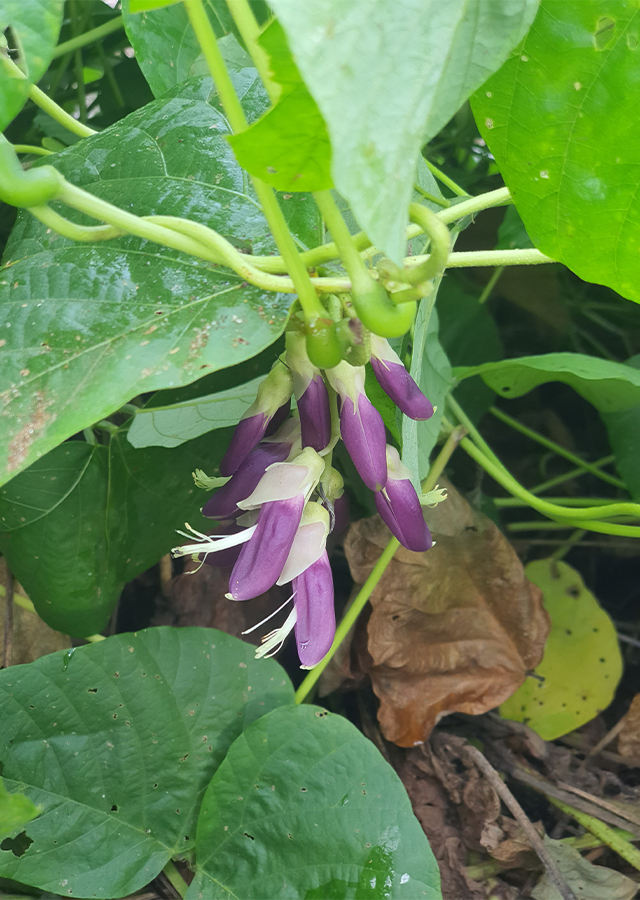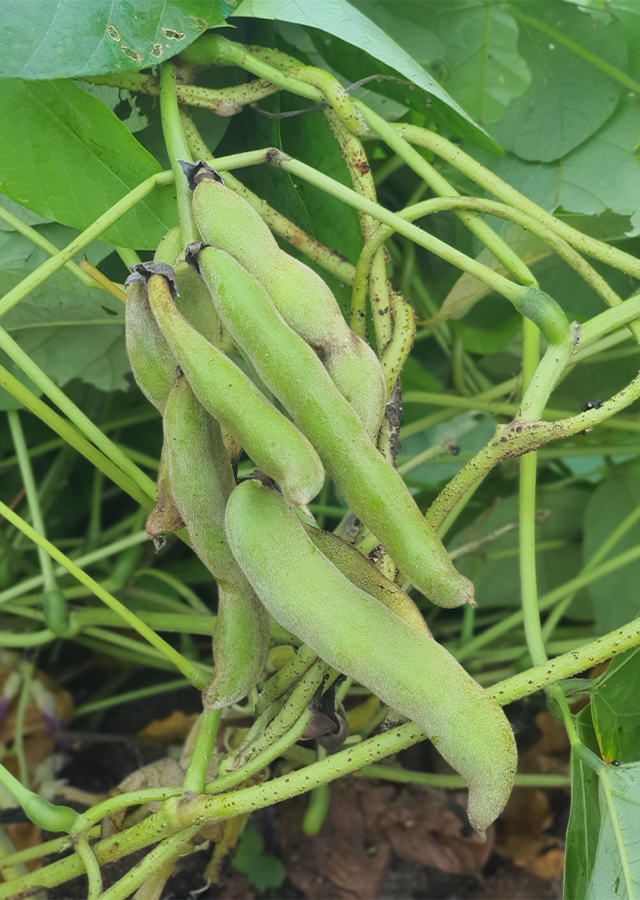Velvet Bean
Mucuna pruriens (L.) DC.
Fabaceae
Location in our garden
Vegetable



Synonym
Carpopogon pruriens (L.) Roxb.
Dolichos pruriens L.
Hornera pruriens (L.) Neck.
Habitus
Climbers. A climbers or spreading, annual, hairy vine with a length of 6-8 m
Part Used
Young pods
Leaves
Seeds
Roots
Growing Requirements
Drought Resistant
Habitat
Riverbanks
Forest
Roadside
Shrublands
Grassland
Overview
Velvet bean is a tropical legume native to Africa and tropical Asia and widely naturalized. In Indonesia, particularly Java, the beans are eaten and widely known as ‘Benguk. The beans can also be fermented to form a food similar to tempe and known as Benguk tempe. It is also a widespread fodder plant in the tropics. The plant can be grown as a ground cover and green manure. It is known as medicinal plants and material in Ayurveda.
Vernacular Names
Dây sắn (Vietnamese), Ma mui (Thailand), Mukuna pururiensu (Japanese). Poil à gratter (French), Juckbohne (German), Nipai (Tagalog-Phillipines), kara benguk (Javanese-Indonesia).
Agroecology
Tropical plant, that is found up to 2,100 m elevation. It is grow best at temperature range 20-30°C, with annual rainfall 1,000-2,000 m, in well drained of fertile soil with soil pH 5-7, under full sun or partial shade. In the wild, it is found in wide range of soil types from sandy soils, loams, limestone and volcanic soil with wide range of soil pH from 4 to 8. It is described as drought tolerant plant.
Morphology
- Leaves - leaflets are thin, ovate to oblong-ovate, 5-12 cm long, the lateral ones oblique.
- Flowers - racemes are pendulous, 10-25 cm long, with many flowers. Calyx is gray-hairy with intermixed brown, stinging hairs. Corolla is dark purple, almost black, about 4 cm long.
- Pods - stout, compressed, slightly curved near the apex, 6- 11 cm long, 2 cm wide, densely covered with stiff, somewhat appressed, brown, very irritating, stinging hairs.
- Seeds - ovoid, about 12 mm long, compressed, brownish, and mottled with black.
Cultivation
- Propagated by seeds.
- The seedpods are harvested when ripe and the hairs scraped off.
Chemical Constituents
Alkaloids, prurienine, ß-sitosterol, glutione, lesitine, venolat acid, triptamine, alkilamine, steroids, flavonoids, terpenoids, mucunadine, mucunain, essential oils, dopamine. It is also contain Serotonin, ß-sitosterol, glutathione, lecithin, venolic acid, and gallic acid.
Traditional Medicinal Uses
Medicinal Uses
- It is an irritant, rubefacient herb that destroys internal parasites, is diuretic and aphrodisiac.
- The seed contains substances which revolutionized the treatment of Parkinson's Disease. The seeds also contain hallucinogenic toxic compounds.
Traditional Uses
- The roots are diuretic and purgative. They are used internally in the treatment of paralysis, nervous complaints, cholera and kidney problems. Externally, they are used in the treatment of elephantiasis and dropsy.
- In India, roots are used as tonic. Infusion of root mixed with honey is prescribed for cholera. In the West Indies, decoction of root is used as powerful diuretic and kidney cleanser. Also, an ointment from the roots used for elephantiasis. In Suriname traditional medicine, ointment is used for swollen glands.
- Vinous infusion of pods is used as remedy for dropsy.
- In Brazil, seed is used internally for Parkinson's disease, edema, impotence, intestinal gas and worms.
Part Used
Reference Sources
- Echo Community. (No date). Velvet Bean. https://www.echocommunity.org/resources/398d94f4-59aa-4500-b535-a08e67f8d78b. 23-02-2021
- Health Jade. (No date). Mucuna pruriens. https://healthjade.net/mucuna-pruriens/. 23-02-2021
- StuartXchange. (2021). Philippine Medicinal Plants. Nipai. http://www.stuartxchange.org/Nipai.html. 23-02-2021
- Ken Fern. (2021). Mucuna pruriens. Tropical Plants Database. tropical.theferns.info. https://tropical.theferns.info/viewtropical.php?id=Mucuna+pruriens. 2021-11-30.
- K.R. Dahal & J.L.C.H. van Valkenburg (2003). Mucuna pruriens (L.) DC. In Lemmens, R.H.M.J. and Bunyapraphatsara, N. Plant Resources of South-East Asia (PROSEA) No 12(3): 308.
- K.R. Dahal & J.L.C.H. van Valkenburg (2003). Mucuna Adanson. In Lemmens, R.H.M.J. and Bunyapraphatsara, N. Plant Resources of South-East Asia (PROSEA) No 12(3): 305-308.


